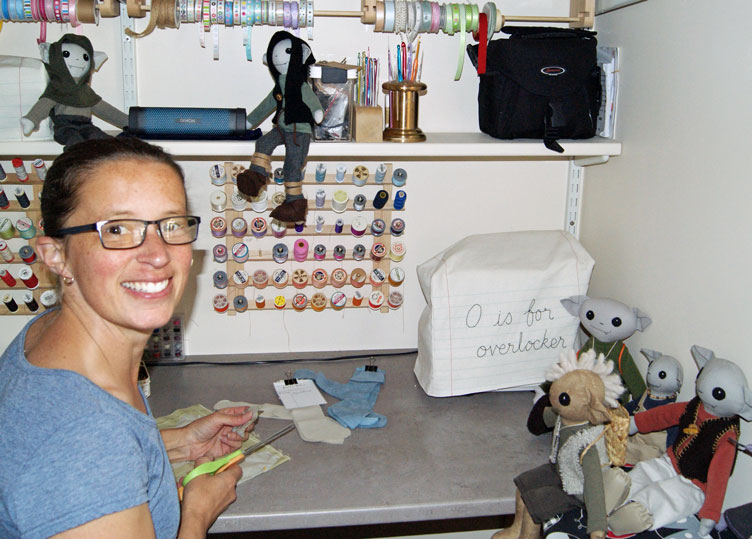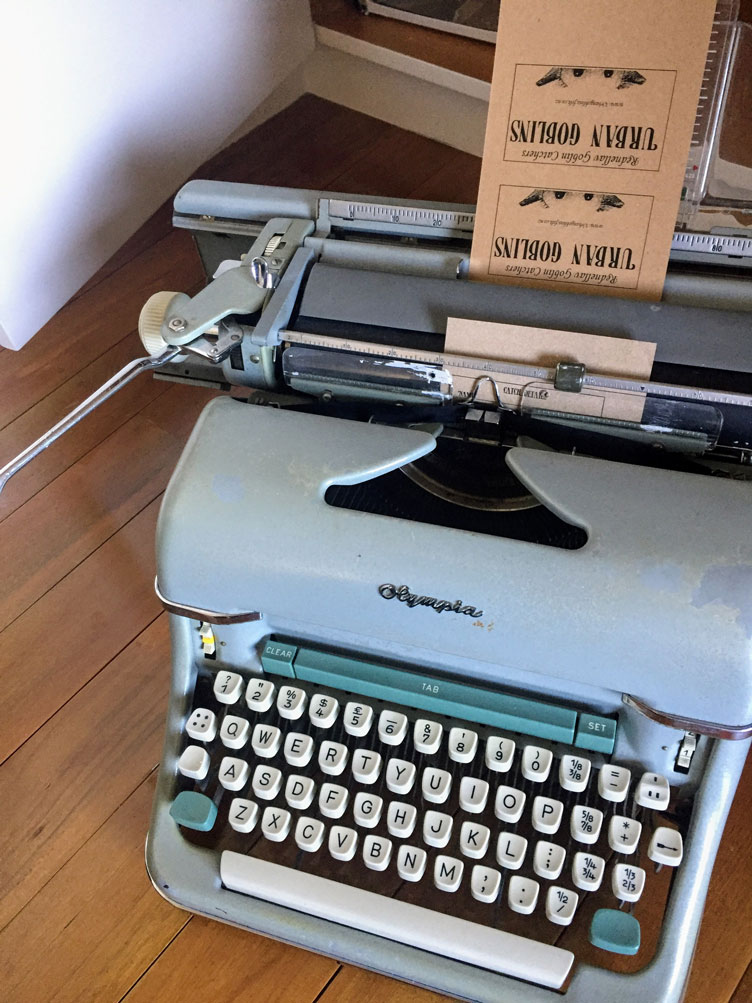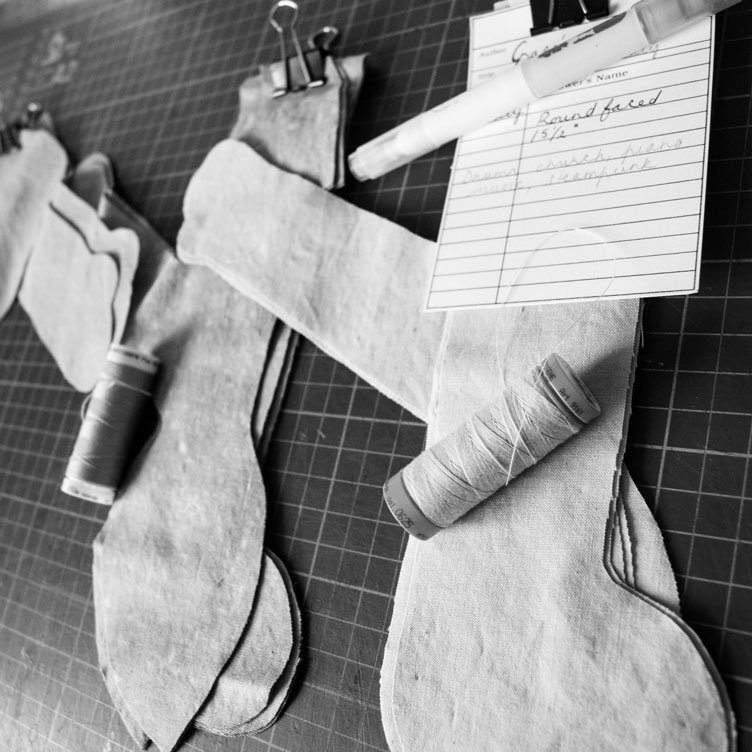Goblin wrangler and librarian Pam Vallender of Rednellav Goblin Catchers reckons her Urban Goblins are rather like weka, magpies, or UK urban foxes: they’ve ended up in our back yards because people have made it possible. Her goblins know that where there are people, there are interesting things to eat and shiny objects and materials to make into nests – if you’re clever!


What do you make?
I make goblins. Well, really I make dolls that look like goblins. I make them as fun, rascally characters for kids, hopefully to be played with until they’re threadbare and smell funny, but adults seem to like them too!
How did you get into your craft?
I’ve always been interested in making dolls and animal toys, especially soft ones. I have vague memories of hand sewing a tiny, under-stuffed teddy bear out of scraps of pyjama material while Mum was making us new PJs. He lived in a cardboard box house with another tiny bear (they had weird decor; chunky little wooden furniture I nailed together and painted with blackboard paint).
The goblins evolved from a basic boy rag doll, Fred, that I made for my son when he was three (in the absence of any other male dolls that weren’t hard plastic and toting wildly inaccurate weaponry) and a weird little folksy rabbit toy I made from a magazine pattern. It looked like a miserable cat. I tried to modify it and when I turned the ears upside down, they reminded me of goblins… so I made a weird little folksy goblin in snot coloured fabric! He was cute but not very durable, unlike Fred, so with a few modifications to the Fred pattern and a couple of serious fails (the Straight-In-The-Bin kind), the Goblins were born. I now make them in two varieties: flat faced and round faced, the results of various pattern modifications and combinations – and I couldn’t choose between the two.
(P.S. Fred still lives with us, but he’s been through repeated surgeries and has retired to my book shelf. My son is travelling around Europe with a mini goblin instead.)
Do you have formal training or qualifications in your craft?
None whatsoever, unless you include manual training at primary school. Basically, I was allowed to use scissors, needles, pins, (and hammers, nails, saws and oil based paint – all the fun stuff) from an early age at home. I’m from a family and family-in-law of “makers” so I’ve had guidance when I’ve asked for it, but mostly I’ve observed, experimented and learnt from books. YouTube, Google and Pinterest are brilliant, but books are still my favourite.


Your favourite materials, tools and processes?
I like natural fabrics, so the goblins are all made out of cotton and I’m always on the hunt for particularly bogey looking colours and patterns for the perfect goblin skin. My favourite and most used tools are fold-back clips for holding all the cut pieces together, little safety pins for holding the pattern pieces together, Japanese chopsticks (which are more tapered than other chopsticks) for turning and stuffing, my air erasable pen and good quality hand sewing needles. But my all time favourite tool is the massive, impractical and extremely heavy 1950s West German typewriter I use to type details on the labels for packaging… it’s so heavy that I keep it on the bottom shelf of a cupboard and drag it onto the floor to type. Sort of like typist yoga!


Tell us about some of the techniques involved in producing one of your goblins
There’s a lot of unpicking before I even start sewing – I get whole garments that look like potential goblin clothing and I pick them apart, keeping even little bits like collars and cuffs. I also collect random objects that might make good goblin adornments, like ladies’ sandal buckles and broken zipper tags (possibly I’m the only Mum that is slightly pleased when yet another hoody zip gets jammed and breaks).
Although their faces are quite simple and plain, I spend quite a bit of time making them match how they look in my head. Eyes are sewn on first, more or less in a set position for all goblins, then I draw their mouths on paper until I have have the one that conveys their attitude. Once I’m convinced that it’s the right mouth, with the right amount of teeth, I’ll try it on their face with my air erasable pen, when that works, I hand stitch it on. Then the nose goes on, and any eyebrows or lashes.
What inspires you?
The Middle Ages and children’s fantasy books and movies. The Middle Ages because of the clothing and accessories – it’s all boar tusks, linen, wool, leather and functionality. Some of the goblins I have made have a real Viking-in-the-off-season look about them (I hope they get to live with a rampaging five year old – grubby goblin in one hand and a stick in the other). And children’s books and movies because they have creatures in them that could easily hang out with the goblins, plus situations the goblins could easily get themselves into.
I love stories that have a bit of darkness and a dash of humour, particularly the type of humour in Terry Pratchett’s and Neil Gaiman’s books, they have definitely influenced the idea of Rednellav Goblin Catchers and the goblins’ individual stories. I really like Spiderwick, Miss Peregrine’s Home For Peculiar Children (books and movie) and anything at all made by Tim Burton, but my favourite is Labyrinth which has amazing costuming and puppetry details (and goblins, lots of goblins).



Is there a philosophy behind your work?
Not really, but I do hope some of these goblins make it into some quirky kid’s toy box or get tucked in with them at night. I used to love seeing Fred bobbing in a tricycle drink bottle holder as he was raced around the deck, or go whizzing down the big slide at the playground as an advance party, or get stuffed into my husband’s jacket pocket on a long walk. He once ended up with the captain on the bridge of the InterIsland ferry (long story, happy ending). Goblins too, are made for adventures – even the lazy ones!
Describe your creative process:
I plan a lot, in my head mostly. I’ll be in a second hand store and I’ll see a texture or pattern in a pair of trousers or woollen jersey and that will give me an idea for a goblin outfit. The outfit will trigger the idea for the goblin – what kind of goblin would wear that fabric, why would he wear it, where did he get it (they’re pretty much all boys… I’ve only made one girl goblin so far).
I don’t usually start actually sewing the goblin until he’s formed in my mind. Things will get changed along the way though, because once a goblin has a face it has a personality and the back story might evolve, which might not go with the original clothes I had planned. Recently my daughter drew me some goblins outlines, which I photocopied and use for sketching outfits onto, which is a bit of fun and helps me clarify my ideas.
Sometimes a goblin is planned around other inspiration, such as a place – the South Island’s West Coast especially, or an incident (like if socks go missing – it had to be goblins, but what do they DO with them?).


Describe your workspace:
Compact! I’m fortunate to have a little room we call The Cave to myself for crafting. There’s plenty of natural light as one wall is mostly window. My husband made two benches, opposite each other, with a set of shelves above each one. One is for sewing and the other is for paper craft, but when I’m mid-project I use both sides for everything. The back of the hot water cupboard encroaches into the Cave, but that’s okay because I can hear the beer fermenting if I listen carefully!
What are you currently listening to?
Beer fermenting! Actually I tend to listen to Youtube or Netflix documentaries while I work, which sounds boring but really isn’t (really… I’ve learnt a lot). When I listen to music it tends to be in conflict with Spotify’s recommendations which leads to a futile battle with a computer algorithm because I refuse to pay for Premium. And then I run out of skips.
What’s your favourite childhood book and why?
The three books by Alain Gree and Philippe Fix about Beebo and Mop (and Mop’s hamster that lived in his stripy jersey). If you search for these now you’ll find that they’re out of print with a starting price around $250 each. I used to borrow them repeatedly from our little local library (those and all of the Asterix and Tintin books). I enjoyed the strangeness of them and the magic in them. They were originally written in French and were translated into English in 1975. Even though they’re for children, they have quite big messages. One of them is about red tape and bureaucracy, one is about identity theft and one is about government control (in a nut shell). They’re creative and a bit surreal. You can see one here.
What are you reading now?
Tales From a Tall Forest by Shaun Micalleff and Jonathon Bentley.


A favourite quote:
“If you trust in yourself… and believe in your dreams… and follow your star… you’ll still get beaten by people who spent their time working hard and learning things and weren’t so lazy.”
Terry Pratchett, The Wee Free Men.
What would your advice be for those starting out in a crafty business?
As I’m just starting out myself, I’m not the best person to ask for advice. So far, I can suggest you just give it a go, make it your best work and be prepared to promote yourself and what you make where-ever you can. I do think that if your crafty business is your primary income, you will need to work constantly at promoting it on social media, markets, local papers – whatever you can do.
What was the last handmade item you bought and what attracted you to it?
I bought three metres of braided sennit (coconut fibre) from a lady in the Salelologa market in Samoa, for making goblin accessories and other crafts. I like the texture of it and it smells earthy, I wish I’d bought more because it’s quite strong and would have all sorts of uses.
What’s in store for the rest of 2018?
I work full time, am a Mum-Taxi and have too many hobbies, so all I have planned goblin-wise is to try to have at least six in the shop and to expand my crochet skills so that I can make a hat that accommodates goblin ears without covering their eyes.
Prize draw!
Here’s your chance to have the best-dressed goblin in town! Adopt an urban goblin from Rednellav Goblin Catchers’ Felt shop before the end of July and go in the draw for an extra set of stylish clothes for your goblin.
If you would like to be in to win some goblin fashion, adopt a goblin from Pam’s Felt shop before 5pm on Tuesday 31 July. Draw open to New Zealand residents only.
Let us know in the comments section what you enjoyed reading about Pam and her awesome goblins!







Librarians rock! A very cool concept and very inspiring story of creativity. Thank you.
Love your uniqueness! These goblins are so amazing and I love, love your story, so open and honest and very funny 🙂
So cool! Your work is stunning and full of wicked details! I specially like that they wear jewellery ❤️